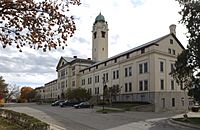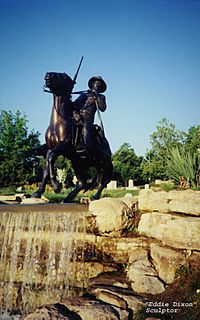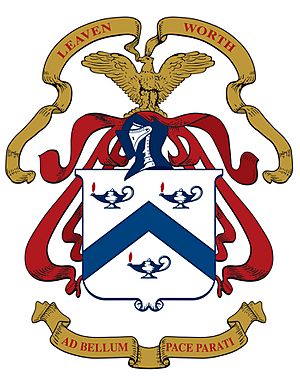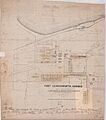Fort Leavenworth facts for kids
Quick facts for kids Fort Leavenworth |
|
|---|---|
| Leavenworth, Kansas | |

Grant Hall headquarters of the U.S. Army Combined Arms Center
|
|
| Type | Army post |
| Site information | |
| Controlled by | |
| Site history | |
| Built | 1827 |
| In use | 1827–present |
| Garrison information | |
| Past commanders |
LTG David G. Perkins |
| Garrison | Command and General Staff College 15th Military Police Brigade (705th Military Police Battalion) |
Fort Leavenworth is a historic United States Army installation located in Leavenworth, Kansas. It was built in 1827, making it the second oldest active U.S. Army base west of Washington, D.C.. It is also the oldest permanent settlement in Kansas. Fort Leavenworth is often called the "Intellectual Center of the Army" because it's a major training hub.
In the past, Fort Leavenworth was a key stop for thousands of soldiers, explorers, and settlers heading west. It was also a place where American Indians passed through.
Today, the fort supports the United States Army Training and Doctrine Command (TRADOC). It is home to the United States Army Combined Arms Center (CAC). The CAC helps train Army leaders and develops important Army strategies.
Fort Leavenworth also has the Military Corrections Complex. This includes the United States Disciplinary Barracks, which is the only maximum-security military prison for the Department of Defense. The fort also supports other groups, like the United States Army Command and General Staff College.
The fort covers about 5,600 acres. It has over 1,000 buildings and 1,500 homes. It sits on the Frontier Military Scenic Byway, an old military road.
Fort Leavenworth was also where the U.S. 10th Cavalry Regiment was formed in 1866. These African-American soldiers were known as Buffalo Soldiers. Native American tribes gave them this nickname. The name eventually applied to all African-American regiments formed around that time.
Contents
What Happens at Fort Leavenworth?
Fort Leavenworth is known as the "intellectual center" of the Army. This is because a big part of its job is training soldiers and leaders.
One of the most important places here is the United States Army Combined Arms Center (CAC). Inside the CAC is the United States Army Command and General Staff College. This college is like a graduate school for U.S. and allied soldiers. Most Army majors train here. Many famous generals, like Dwight Eisenhower and Douglas MacArthur, studied at this college.
The fort also has the United States Disciplinary Barracks. This is the only maximum-security prison for military members from all branches of the U.S. armed forces. There is also the Midwest Joint Regional Correctional Facility, which is a lower-security prison.
Other important groups at the fort include:
- Foreign Military Studies Office: They study military topics from around the world.
- Munson Army Health Center: This is the fort's hospital.
- Sherman Army Airfield: This is the fort's airport.
- Fort Leavenworth National Cemetery: A special burial ground for veterans.
Schools for Military Families
The Fort Leavenworth School District runs schools for students from Pre-Kindergarten to 8th grade. Older students attend Leavenworth High School in the nearby city of Leavenworth.
Fort Leavenworth's Long History
Early Days: The 1800s
Fort Leavenworth was established in 1827 by Colonel Henry Leavenworth. He and his soldiers built it to protect the Santa Fe Trail. This trail was an important route for trade and travel.
Colonel Leavenworth chose the spot on the bluffs above the Missouri River. The first army camp, originally called Cantonment Leavenworth, had 14 officers and 174 soldiers.
The fort quickly became very important. It was the starting point for both the Santa Fe Trail and the Oregon Trail. In 1832, its name was changed to "Fort Leavenworth."
The Rookery, built between 1832 and 1834, is the oldest building in Kansas. It was once the office of Kansas's first governor.
In 1836, a large area of land across the Missouri River was transferred to the U.S. government. This was known as the Platte Purchase.
During the Mexican–American War, Fort Leavenworth was a key place for preparing soldiers.
Civil War and Beyond

During the American Civil War, Fort Leavenworth was a training camp for Kansas soldiers. Even though defenses were built, the fort was never attacked by enemy forces.
After the Civil War, the Army's main job was to manage conflicts with American Indian tribes in the West.
The Fort Leavenworth National Cemetery was created in 1862. Veterans from many wars, including the War of 1812, are buried here. Brigadier General Henry Leavenworth, who the fort is named after, is buried here.
In 1866, the U.S. Congress created four African-American regiments. The 10th Cavalry Regiment was formed at Fort Leavenworth. These soldiers became known as "Buffalo Soldiers." A statue at the fort honors them.
The United States Disciplinary Barracks, a military prison, was set up in 1875.
In 1881, General William Tecumseh Sherman started a school here. This school grew into the United States Army Command and General Staff College.
The 1900s and Today
Graduates of Sherman's school played a big role in World War I. They helped plan many important operations. Between the world wars, future leaders like Dwight D. Eisenhower studied here. During World War II, about 19,000 officers trained at Fort Leavenworth.
In 1946, the school got its current name. In 1959, it moved to the new J. Franklin Bell Hall.
Fort Leavenworth was named a National Historic Landmark in 1960. This means it's a very important historical site.
The base has the Sherman Army Airfield. It has a long runway and is used by both military and civilian planes. The airfield has been flooded by the Missouri River during big floods, like in 1951, 1993, and 2011.
Freedom's Frontier Heritage Area
Fort Leavenworth is one of the most important military sites in the U.S. Army and the nation. A large part of the fort is a National Historic Landmark District.
In 2006, Fort Leavenworth became part of the new Freedom's Frontier National Heritage Area. This area highlights important historical sites related to the settlement of the West and the struggle for freedom.
Images for kids





